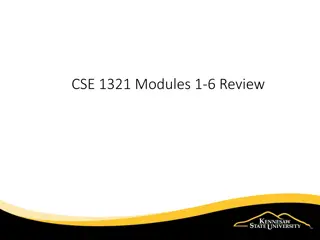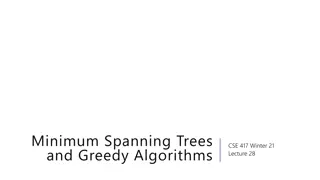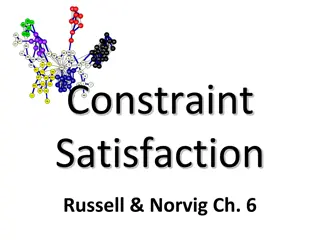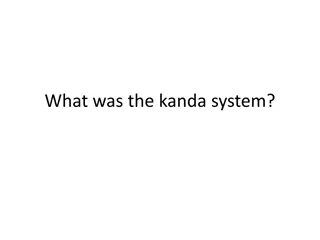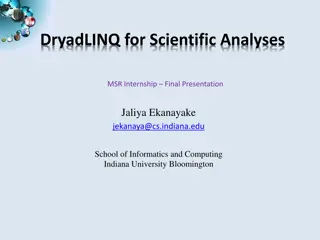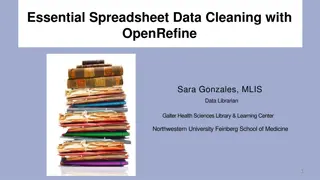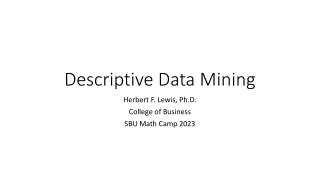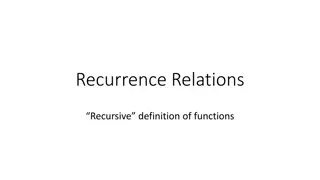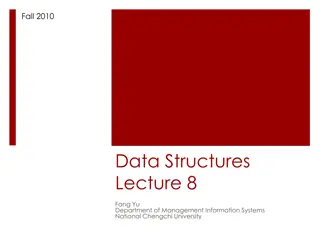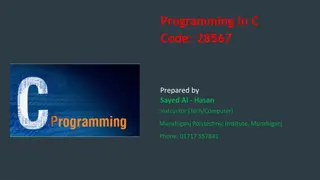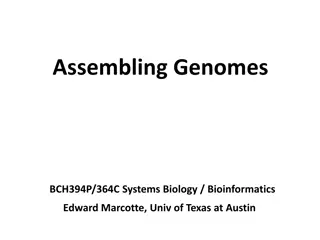Understanding Clustering Algorithms: K-means and Hierarchical Clustering
Explore the concepts of clustering and retrieval in machine learning, focusing on K-means and Hierarchical Clustering algorithms. Learn how clustering assigns labels to data points based on similarities, facilitates data organization without labels, and enables trend discovery and predictions through groupings.
Download Presentation
Please find below an Image/Link to download the presentation.
The content on the website is provided AS IS for your information and personal use only. It may not be sold, licensed, or shared on other websites without obtaining consent from the author. Download presentation by click this link. If you encounter any issues during the download, it is possible that the publisher has removed the file from their server.
Presentation Transcript
Clustering and Retrieval Applied Machine Learning Derek Hoiem Dall-E
Recall from last lecture: What are three ways to mitigate problems in bias from AI algorithms? Model cards Data sheets Intersectional performance analysis Adversarial algorithm to prevent using features that predict sensitive attributes such as race or gender Multi-task learning to facilitate learning of less common classes
Weve learned a lot about supervised prediction algorithms now we will learn about methods to organize and analyze data without labels Clustering and retrieval EM and missing data Estimating probabilities for continuous variables Projections for compression and visualization Topic modeling Anomaly detection
Todays lecture Clustering Kmeans Hierarchical Kmeans Agglomerative Clustering Retrieval Using Hierarchical Kmeans LSH Faiss library
Clustering Assign a label to each data point based on the similarities between points Why cluster Represent data point with a single integer instead of a floating point vector Saves space Simple to count and estimate probability Discover trends in the data Make predictions based on groupings
K-means algorithm 1. Randomly select K centers 2. Assign each point to nearest center 3. Compute new center (mean) for each cluster Illustration: http://en.wikipedia.org/wiki/K-means_clustering
K-means algorithm 1. Randomly select K centers 2. Assign each point to nearest center Back to 2 3. Compute new center (mean) for each cluster Illustration: http://en.wikipedia.org/wiki/K-means_clustering
K-means Demo https://www.naftaliharris.com/blog/visualizing-k-means-clustering/
What is the cost minimized by K means? 2 ,??????? = ????????,??????? ?? ?????????? ?? ? 1. Choose ids that minimizes square cost given centers 2. Choose centers that minimize square cost given ids
Implementation issues How to choose K? Can use MDL (minimum description length) principle that minimizes a cost of parameters plus cost of negative data log likelihood, but in practice K is almost always hand chosen Often based on the number of clusters you want considering time/space requirements How do you initialize Randomly choose points Iterative furthest point
Evaluating clusters with purity We often cluster when there is no definitively correct answer, but a purity measure can be used to check the consistency with labels ?????? = max ? ?(??????= ?) /? ? ?:???=? Purity is the count of data points with the most common label in each cluster, divided by the total number of data points (N) E.g., labels = {0, 0, 0, 0, 1, 1, 1, 1}, cluster ids = {0, 0, 0, 0, 0, 1, 1, 1}, purity = ? purity = 7/8 Purity can be used to select the number of clusters, or to compare approaches with a given number of clusters A relatively small number of labels can be used to estimate purity, even if there are many data points
What are some disadvantages of K-means in terms of clustering quality? All feature dimensions equally important Tends to break data into clusters of similar numbers of points (can be good or bad) Does not take into account any local structure Typically, not an easy way to choose K Can be very slow if the number of data points and clusters is large
Hierarchical K-means Iteratively cluster points into K groups, then cluster each group into K groups
Advantages of Hierarchical K-Means Fast cluster training With a branching factor of 10, can cluster into 1M clusters by clustering into 10 clusters ~111,111 times, each time using e.g. 10K data points Vs. e.g. clustering 1B data points into 1M clusters Kmeans is O(K*N*D) per iteration so this is a 900,000x speedup! Fast lookup Find cluster number in O(log(K)*D) vs. O(K*D) 16,667x speedup in the example above
Are there any disadvantages of hierarchical Kmeans? Yes, the assignment might not be quite as good, but often usually isn t a huge deal since K means is used to approximate data points with centroid anyway
Agglomerative clustering Iteratively merge the two most similar points or clusters Can use various distance measures Can use different linkages , e.g. distance of nearest points in two clusters or the cluster averages Ideally the minimum distance between clusters should increase after each merge (e.g. if using the distance between cluster centers) Number of clusters can be set based on when the cost to merge increases suddenly https://dashee87.github.io/data%20science/gener al/Clustering-with-Scikit-with-GIFs/
Agglomerative clustering With good choices of linkage, agglomerative clustering can reflect the data connectivity structure ( manifold ) Clustering based on distance of 5 nearest neighbors between clusters https://dashee87.github.io/data%20science/gener al/Clustering-with-Scikit-with-GIFs/
Applications of clustering K-means Quantization (codebooks for image generation) Search Data visualization (show the average image of clusters of images) Hierarchical K-means Fast search (document / image search) Agglomerative clustering Finding structures in the data (image segmentation, grouping camera locations together)
2 minute break Are there any times that you ve used clustering, or that it would be useful?
Retrieval Given a new sample, find the closest sample in a dataset Applications Finding information (web search) Prediction (e.g. nearest neighbor algorithm) Clustering (kmeans)
Vanilla Search Compute distance between query and each dataset point and return closest point https://engineering.fb.com/2017/03/29/data-infrastructure/faiss-a- library-for-efficient-similarity-search/
Faiss library makes even brute force search very fast Multi-threading, BLAS libraries, SIMD vectorization, GPU implementations KNN for MNIST takes seconds https://engineering.fb.com/2017/03/29/data- infrastructure/faiss-a-library-for-efficient-similarity-search/
Inverse document file for retrieval of count-based docs Applies to text (word counts), images (clustered keypoint counts), and other tokenized representations Like a book index: keep a list of all the words (tokens) and all the pages (documents) that contain them. Rank database documents based on summed tf-idf measure for each word/token in the query document tf-idf: Term Frequency Inverse Document Frequency # documents # times word appears in document # documents that contain the word # words in document
Locality Sensitive Hashing (LSH) A fast approximate search method to return similar data points to query
A typical hash function aims to place different values in separate buckets https://www.pinecone.io/learn/locality- sensitive-hashing-random-projection/
LSH aims to put similar keys in the same bucket https://www.pinecone.io/learn/locality- sensitive-hashing-random-projection/
Basic LSH process 1. Convert each data point into an array of bits or integers, using the same conversion process/parameters for each 2. Map the arrays into buckets (e.g. with 10 bits, you have 2^10 buckets) Can use subsets of arrays to create multiple sets of buckets 3. On query, return points in the same bucket(s) Can check additional buckets by flipping bits to find points within hash distances greater than 0
Random Projection LSH Data Preparation Given data {X} with dimension d: 1. Center data on origin (subtract mean) 2. Create b random vectors hb of length d 3. Convert each Xn to b bits: XnhT> 0 h= np.random.rand(nbits, d) - .5 Query 1. Convert Xq to bits using h 2. Check buckets based on bit vector and similar bit vectors to return most similar data points
Key parameter: nbits Example with 1M 128-bit SIFT vectors More bits returns more similar vectors Recall vs. exact nearest neighbor Similarity of LSH-returned vector
Key parameter: nbits Example with 1M 128-bit SIFT vectors But more bits takes more time to query because it needs to search more buckets to find a collision Time compared to brute force search Recall vs. exact nearest neighbor
Key parameter: nbits Rule of thumb: nbits = dim is a decent choice (1 bit per feature dimension) Optionally, can retrieve K closest data points and then use brute force search on those Time compared to brute force search Recall vs. exact nearest neighbor
Nice video about LSH in faiss: https://youtu.be/ZLfdQq_u7Eo which is part of this very detailed and helpful post: https://www.pinecone.io/learn/locality-sensitive-hashing- random-projection/
Things to remember Clustering groups similar data points K-means is the must-know method, but there are many others TF-IDF is used for similarity of tokenized documents and used with index for fast search Approximate search methods like LSH can be used to find similar points quickly Use highly optimized libraries like FAISS





